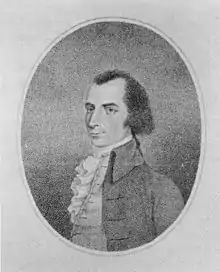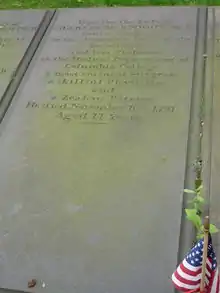Charles McKnight
Charles McKnight (October 10, 1750 – November 16, 1791) was an American physician during and after the American Revolutionary War. He served as a surgeon and physician in the Hospital Department of the Continental Army under General George Washington and other subordinate commanders.[1] McKnight was one of the most respected surgeons of his day[2][3] and was remembered by one colleague as "particularly distinguished as a practical surgeon … at the time of his death (he) was without a rival in that branch of his profession."[4]
Charles McKnight | |
|---|---|
 Pencil drawing of Charles McKnight, made after his death | |
| Born | 10 October 1750 Cranbury Township, Province of New Jersey |
| Died | 16 November 1791 (aged 41) New York City, New York |
| Allegiance | United States of America |
| Service/ | Continental Army |
| Years of service | 1776–1782 |
| Rank | Surgeon General Chief Hospital Physician |
| Unit | Middle Department, Continental Army |
| Other work | surgeon and professor at Columbia College |
Early life
McKnight was born in Cranbury Township in the colonial Province of New Jersey in 1750. His only sibling was his younger brother, Richard. His father, also named Charles McKnight, emigrated to the colonies from Ireland sometime around 1740 and was ordained as a Presbyterian minister in 1742.[5] He became a minister of some note, and was one of the founders and trustees of the College of New Jersey (now Princeton University).[6] Reverend McKnight opposed British governance in Colonial America and was a loud voice for opposition and overthrow of the British government in New Jersey. According to Martha J. Lamb, Reverend McKnight received a severe saber cut to his head in the slashing melee that mortally wounded General Hugh Mercer at the Battle of Princeton.[7] His church at Middletown Point was burned in 1777 and Reverend McKnight was arrested.[8] While in custody aboard the British prison ship HMS Jersey in New York City, Rev. McKnight's health rapidly failed, and he was released shortly before his death on January 1, 1778.[9]
The younger McKnight attended schools in New Jersey and graduated from the College of New Jersey in 1771, in the same class as James Madison, Gunning Bedford Jr., Henry Brackenridge, and Philip Freneau.[10][11] He was one of the founders of the American Whig Society, along with Brackenridge, Madison, Samuel Stanhope Smith, Bedford, Freneau, John Beatty, John Henry of Maryland, and William Bradford.[11][12] McKnight studied medicine and surgery privately with eminent Philadelphia surgeon William Shippen,[3] but left before he completed his studies and entered the Continental Army in 1775.[2]
Continental Army surgeon
In late 1775, Benjamin Church, the Director General, assigned McKnight to the Putnam House building, one of six hospitals of the army's Hospital Department in Cambridge, Massachusetts.[13] He remained in that division, which supported Washington's army, until, during a period of great scarcity of medical and surgical supplies for the sick and wounded, McKnight went with other surgeons and physicians to North Castle, New York with Washington's army when the Battle of White Plains began in October 1776.[14] The Continental Army lost the battle, and the British took Fort Washington and Fort Lee, which pushed Washington's ragged army south toward New Jersey in December 1776, which set the stage for the Battle of Trenton.
McKnight remained at North Castle until John Morgan, the Director General, ordered him and Samuel Adams Jr. (the son of Samuel Adams of Massachusetts) to set up a new hospital near Peekskill, New York, for more than 300 sick soldiers of General William Heath's division. Unable to find an acceptable site for a hospital, the two surgeons took over accommodations in Fishkill, New York, twenty miles north of Peekskill.[15] Washington, however, sent convalescents to Peekskill because Morgan told him the hospital was there. Morgan was dismissed as Director General soon thereafter, in January 1777, due to rancor with Washington over supplies and a rampant smallpox epidemic then raging its way through the army. Morgan's management style rankled the surgeons, including McKnight, as Morgan was wrestling with Shippen, McKnight's mentor, over control of the hospitals in New Jersey.[16] Isaac Foster took over temporary supervision of the hospitals on the east side of the Hudson River after Morgan's dismissal at Washington's request.[17]
McKnight served later as a surgeon in the Pennsylvania Battalion of the Flying Camp.[18] On April 11, 1777, he was appointed Surgeon General (also called Senior Surgeon,[3] a subordinate position to Physician General and Director General,[19] not to be confused with Surgeon General of the United States Army) of the Flying Hospital of the Middle Department,[18][19] which moved with the army during the New York and New Jersey campaign.[20] He served as Senior Surgeon for three years.[21] In December 1779, McKnight was in Morristown, New Jersey with Washington,[22] at the encampment near Jockey Hollow, during the worst winter of the Revolutionary War.
The Hospital Department of the army was reorganized in 1780, and McKnight was promoted to Chief Hospital Physician, the highest medical position of the Middle Department.[21][23][24] He served there until he left the army in January 1782.[9] According to records, he was one of the original members of the New York State Society of the Cincinnati.[25][26]
Later years and death

After the war ended, McKnight settled in New York City, where he married Mary Morin Scott, daughter of General John Morin Scott.[10] He opened a private practice and was one of the first physicians to use a carriage to visit his patients.[2] McKnight published only one article, the surgical removal of an ectopic pregnancy, but the piece was cited later by the Medical Society of London[27] in its London Medical Observations and Inquiries.[2][28]
On November 26, 1784, McKnight was appointed one of the first regents of the University of the State of New York.[25][29] In 1785, McKnight became professor of anatomy and surgery at Columbia College (now the Columbia University College of Physicians and Surgeons), which his father-in-law co-founded. He also was appointed Port Physician of New York.[21] McKnight was remembered as an oculist, and therefore probably performed eye surgery.[30] McKnight maintained a steady surgical practice and held his professorship until his death from pneumonia,[2] the result of an old war injury,[4] on November 16, 1791 at age 41.
McKnight was interred at the corner of Wall Street and Broadway in Lower Manhattan, just beyond the gates of the historic Trinity Churchyard, next to his wife, Mary, and her father. They left four daughters[8] and one son, John Morin Scott McKnight, who also became a physician.[4]
See also
Notes
- Washington, Vol. 17, p. 222.
- Handerson, p. 817.
- Alexander, p. 143.
- Nevet, p. 36.
- Cameron, p. 55.
- Maclean, p. 361.
- Lamb, p. 285.
- Schuyler, p. 260.
- Nevet, p. 35.
- Nevet, p. 34.
- Hunt, p. 15.
- Cameron, p. 56.
- Gillett, p. 51.
- Gillett, p. 72.
- Gillett, p. 73.
- Gillett, p. 67.
- Gillett, p. 74.
- Heitman, p. 373.
- Gillett, Table 1.
- USHistory.org.
- Lamb, p. 284.
- Washington, p.222.
- Gillett, p. 23.
- Risch, p. 406.
- Brown, p. 280.
- Saffell, p. 480
- Sullivan, chapter XIII.
- Footnote 301:" New York Med. and Phil. Journ. and Rev., Vol. I, 1809, p. 163. Charles McKnight communicated a similar case to James Mease (1771-1846) of Philadelphia who sent the report to John Coakley Lettsom (1744-1815). See Mem. of the Med. Soc. of London, Vol. IV, 1795, p. 342: 'Case of extra-uterine abdominal foetus successfully extracted by an operation–By the late Dr. Charles McKnight of N. Y. communicated by James Mease of Philadelphia to Dr. Lettsom."
- McCaughey, p. 62.
- Leffler CT, et al. (2017). "Ophthalmology in North America: Early Stories (1491-1801)". Ophthalmology and Eye Diseases. 9: 1–51. doi:10.1177/1179172117721902. PMC 5533269. PMID 28804247.
References
Primary sources
- Washington, George (1931). John C. Fitzpatrick (ed.). The Writings of George Washington from the Original Manuscript Sources, 1745–1799, vol. 17. Washington, D. C.: United States Government Printing Office. Archived from the original on 2011-02-08. Retrieved 2007-11-05. (14 references to McKnight in the corpus of Washington's writings)
Secondary sources
- Alexander, Samuel Davies (2007-01-17). Princeton College during the Eighteenth Century. Kessinger Publishing. ISBN 978-1-4304-7625-2. OCLC 1920998.
- Brown, John Howard, ed. (1902). Lamb's biographical dictionary of the United States. Vol. 5. Boston: Federal Book Company of Boston. Retrieved 28 December 2010.
- Cameron, Henry Clay; Field, Richard Stockton; American Whig Society (1871). Addresses and proceedings at the celebration of the one hundredth anniversary of the founding of the American Whig society: of the College of New Jersey, Princeton, N. J., June 29, 1869. Princeton, New Jersey: Stelle & Smith. Retrieved 29 December 2010.
- Gillett, Mary C. (1981). The Army Medical Department 1775–1818. Washington, D. C.: United States Government Printing Office. ISBN 1-4102-0238-0. Archived from the original on 2007-06-21. Retrieved 2007-06-21.
- Handerson, Henry Ebenezer; Baas, Johann Hermann (1889). Outlines of the History of Medicine and the Medical Profession. New York: J. H. Vail. OCLC 1995729.
- Heitman, Francis B. (2000). Historical Register of Officers of the Continental Army During the War of the Revolution, April 1776 to December 1783 (paperback ed.). Genealogical Press Company. ISBN 0-8063-0176-7. OCLC 47884845.
- Hunt, Gaillard (November 1902). The Life of James Madison. New York: Doubleday, Page, & Co. ISBN 9780722288511. OCLC 288034086. Retrieved 28 December 2010.
- Lamb, Martha J.; Harrison, Mrs. Burton (2005-11-01). History of the City of New York: Its Origin, Rise And Progress - Volume 2 (paperback ed.). New York: Cosimo. ISBN 1-59605-284-8. OCLC 70676667. Retrieved 2010-12-29.
- McCaughey, Robert A. (2003). Stand, Columbia : A History of Columbia University in the City of New York, 1754-2004. New York: Columbia University Press. ISBN 0-231-13008-2.
- Maclean, John (1877). History of the College of New Jersey: From Its Origin in 1746 to the Commencement of 1854. Philadelphia: J.B. Lippincott. OCLC 39536434.
- Nevets, S. D. (1877). "Historic Characters—Souvenirs of the Revolution". Potter's American Monthly. Philadelphia: John E. Potter & Co. (VIII & IX): 34–36. OCLC 56606757.
- Ricci, James Vincent (1990). The development of gynæcological surgery and instruments. Norman Publishing. ISBN 978-0-930405-28-1. Retrieved 30 December 2010.
- Risch, Edna (1981). Supplying Washington's Army. Special Studies. Washington, D.C.: United States Army Center of Military History. OCLC 6279378.
- Saffell, William Thomas Roberts (1995). Records of the Revolutionary War. Conway, Arkansas: Oldbuck Press. ISBN 1-56869-102-5. OCLC 33018615.
- Schuyler, John (1886). Institution of the Society of the Cincinnati. New York: Douglas Taylor. p. 260. OCLC 37989257.
- Sullivan, James; Williams, Melvin E.; Conklin, Edwin P.; Fitzpatrick, Benedict, eds. (1927). "Chapter XIII. The Medical Profession.". History of New York State, 1523–1927 (PDF). Vol. 5. New York City, Chicago: Lewis Historical Publishing Co. pp. 2027–126. hdl:2027/mdp.39015028558818. Wikidata Q114149630.
- "Who Served Here? Physicians, Surgeons and Mates with Washington at Valley Forge". USHistory.org. Independence Hall Association. Archived from the original on 2010-10-22. Retrieved 2007-06-20.